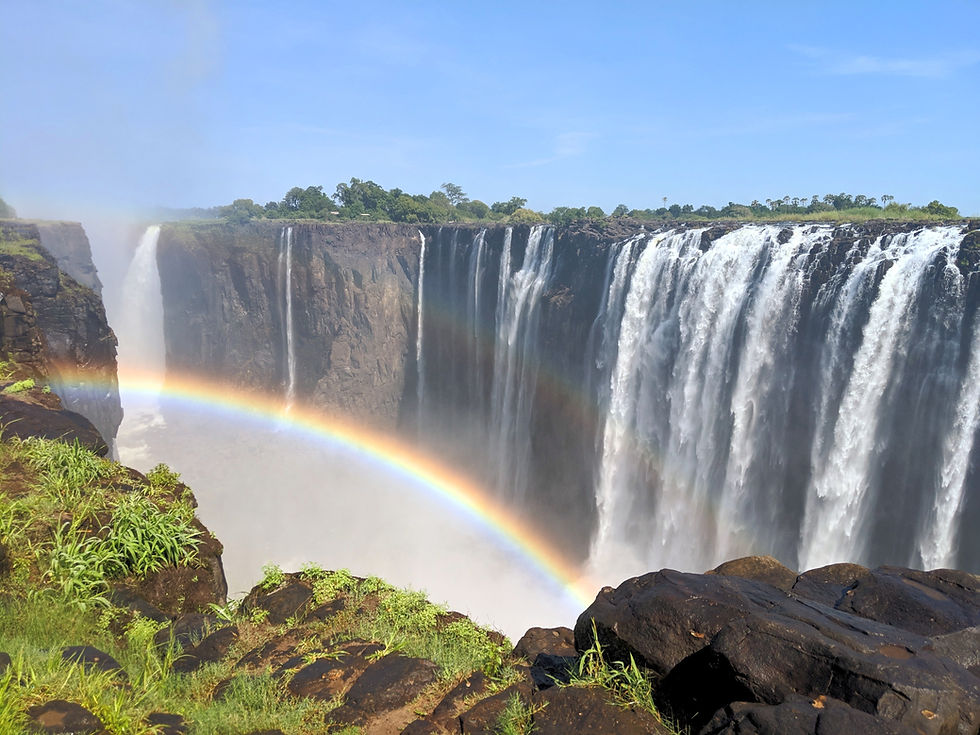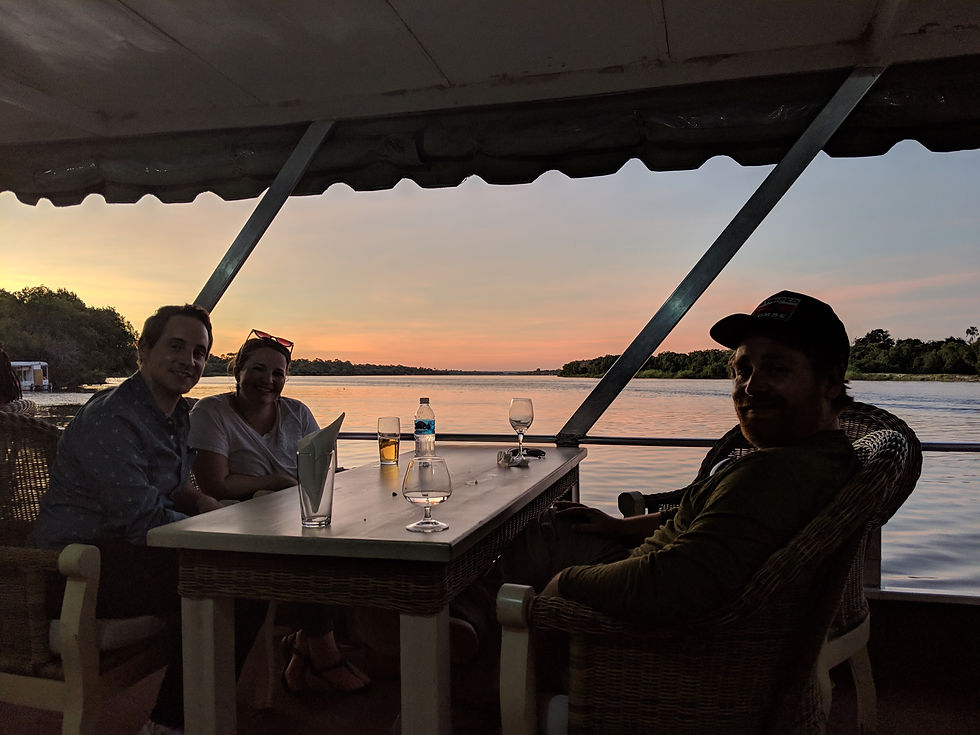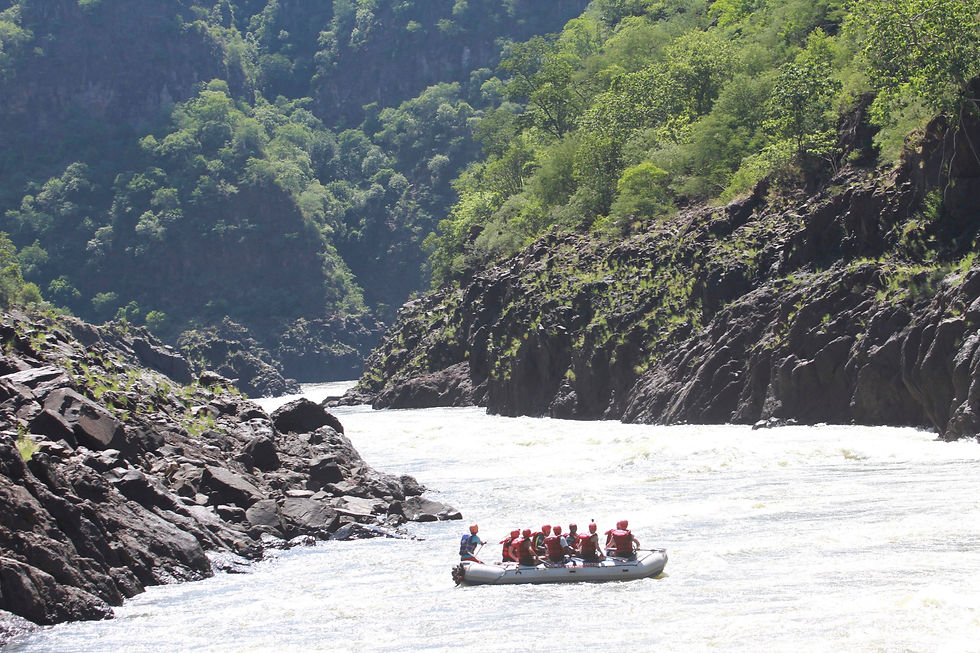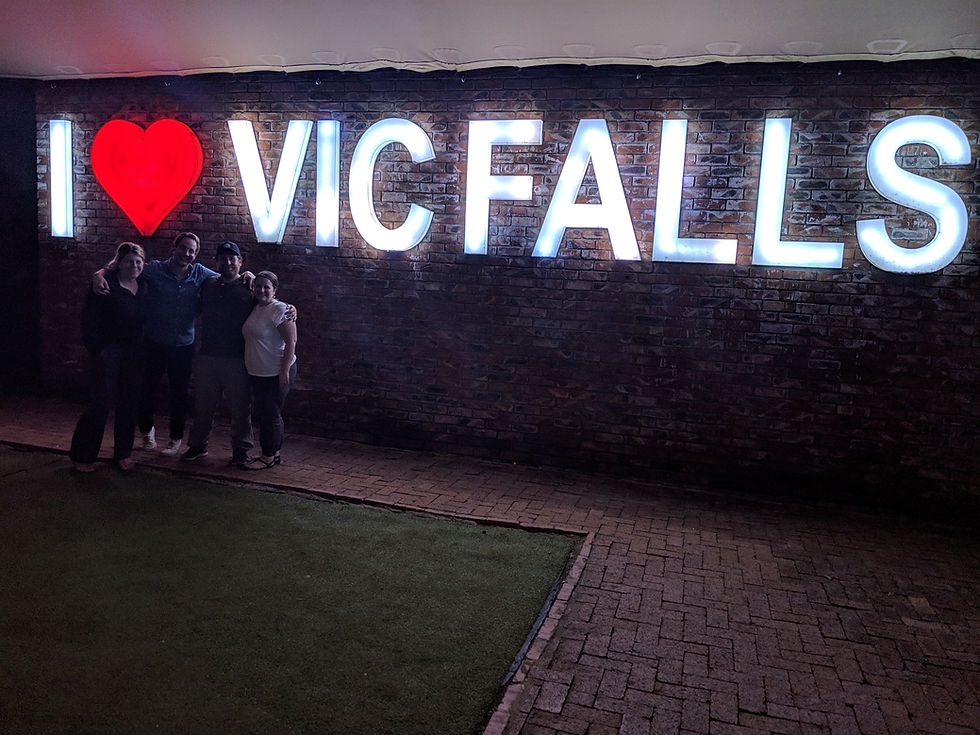Go white water rafting, enjoy a sunset river cruise, sit on the edge of a waterfall, safari in Botswana and hike to viewpoints of the largest waterfall in the world.

Jump Ahead to a Section:
Day One
Sunset Cruise
We arrived mid-afternoon the first day and arranged to go on a sunset dinner cruise that night. The cruise goes down the Zambezi River so you will likely see hippos, crocodiles, and birdlife while having cocktails and canapés. There are many options on these cruises in terms of the size of the boat and what’s included for beverages and food. After researching, we decided the Zambezi Royal looked like the best option for the sunset cruise. It is a small, one-level boat, and beer, wines, and hot appetizers made by a chef on board are included. It only allows a maximum of 28 people. The smaller jet boats can also maneuver into more shallow water than the bigger boats. We loved this experience. It was the perfect way to start the trip. The sunset was vibrant over the water, we had animal sitings and the food was delicious too.

The various cruises range in price from free (tour operators will include a cruise for free with other bookings) to $75USD per person for a luxury option with a full meal. So if you are looking to save money negotiate one as an add-on with your other bookings.

Day Two
Whitewater Rafting
Our group split into two this day, half of us booked white water rafting and the other half booked a micro flight over the Falls. I chose whitewater rafting so I will outline that experience here. Our friends that experienced the micro flight loved it too. The micro flight was $175USD per person.
For whitewater rafting, the experience varies depending on what time of year you go.
Low Water Rafting
Usually August through December.
Rafters typically only complete rapids #1 to #19 or #21, depending on the company.
Rafters can view the Falls and the bridge when the ride starts.
There are a few companies that offer half or full-day options during low water season.
If paddling class 5 rapids and having the most exhilarating experience possible is important to you, low water rafting season is the best time to visit.
High Water Rafting
Usually January through July
Rafters typically only complete rapids #11 to #23 because the other rapids are too dangerous.
It is a shorter day than the low water rafting season, but the rafting companies still charge the same amount for the excursion.
We visited during high water rafting and there are still a few big rapids and we still had people fall out of the raft. There were also many small/easier rapids too.
If water levels are too low, rafting may not be available in April and May. It depends on the rains that year.
The whitewater rafting day starts with an orientation (note this is the last chance for a bathroom). This is also where the guides will see if anyone wants to take an oar boat rather than a paddle boat. The oar boat is completely controlled by the guide, whereas in the paddle boat, everyone on board helps paddle. I was interested in an oar boat, but no one else in the group was, so I ended up paddling. If an oar boat is important to you, make sure to be clear about that when you book.
After orientation, the guides drive you to the top of the landing site to distribute helmets, paddles, and to help rafters bag up and leave any additional belongings behind. Then everyone begins the hike down to the water. The hike down isn’t too bad, but it is steep and on a cliff, so it’s not an easy walk either.
A few notes-
Don’t bring a camera or any other valuables. They will make you pack up all of it at the top and not bring it anyways. The rafting company takes pictures of the outing and offers them for sale. One company included them for free with the booking.
Check with your rafting company to confirm if they allow sunglasses. The company may not allow them or they may require that the sunglasses have a string or a way to attach to you.
Be sure to hydrate plenty the day before and that morning. The guides don’t allow rafters to carry water once the hike down begins. The full day in the sun plus the hikes both ways make for a dehydrating day.
Wear shoes that either you don’t care about losing or that will stay on tight. I wore hiking sandals and ended up falling in the rapids and they stayed on. I recommend sturdy footwear to hike in, not flip-flops.
Wear a swimsuit, shorts and a t-shirt. Avoid wearing anything that you think the water will wash away if you end up in the rapids. There are opportunities along the rafting route to swim in calmer waters.
You could also bring a small thing of sunscreen that you don’t care about losing and wear a hat for sun protection under your helmet.
The hike down to the river has a gorgeous view and was also an enjoyable part of the day.
Once down to the river, each guide has their rafters settle into their boat and then goes through practice drills with the boat team before heading to the rapids. Rafting in the lower part of the gorge provides a different perspective of the Falls area than the hikes from above. There are a few quiet points of the river where rafters can hop and in and casually swim.

The rapid portions are wild and it is best to assume that you will fall in at some point. I personally fell in during one of the tough rapids. Reading online reviews it seems like it is relatively common for a rafter to fall in compared to the rafting I have experienced in the States where it’s much rarer to flip or have people fall in. The rafting outing includes the services of a couple of safety kayaks that follow the rafts to help rescue people that fall in.

After the rafting, you then have to hike back up the cliff to the lunch and transit spot. This hike after rafting can take anywhere from 20 minutes to an hour depending on your level of fitness. It is tough, straight uphill, with no water for a little over a kilometer. The guides are patient with rafters who take a while to make it up. Then they will have cold beverages and lunch ready for you at the top. The whole day with lunch costs $120USD per person.
Spend the evening in Victoria Falls town at one of the restaurant or bar options mentioned above in Where to Eat.
Day Three
Botswana Safari
It is only an hour and a half drive to Chobe National Park in Botswana from Victoria Falls, so we decided to spend one day enjoying a safari in this park. Chobe is known to have the largest elephant population in the world. See the Tips section on the best time of year to visit.

We started the day being picked up and then driven to Botswana. It is an hour and a half drive plus the time spent completing the entry process at the border.
Once we arrived we stopped at a lodge to use bathrooms and regroup and then launched our river boats from there. We had the morning safari via boat on the river and the afternoon one via car. Especially if you go during the dry season I highly recommend booking the boat for part of the day. It’s a safari experience that isn’t possible in many other parks.

Seeing the animals congregate and interact along the water is a fun experience. We saw hundreds of elephants playing in the water or near the water. We also saw hippos and crocodiles from the boat.

After the boat portion of the day, they took us back to the lodge for lunch for a fresh buffet lunch with lots of options. That afternoon we broke off into smaller groups for the driving portion of the safari. We saw lots more elephants, zebras, baboons, kudu, giraffes, and a couple of leopards too. Chobe has all of the big five animals within the park, but it’s probably hard to see them all during a day trip. The full day with lunch costs $160USD per person.

Day Four
Victoria Falls from both sides
We started day four walking along all of the upper viewpoints of the Falls on the Zimbabwe side. It is the more popular side of the falls so we went early to beat the crowds. The crowds were not terrible, but going early helped us to stay in front of tour bus groups. It costs $ 30 USD per person for entry to the park. The trail in the park is an easy walk with clear pathways, so it’s not true hiking or difficult. There is no minimal to no elevation gain. Pack a raincoat for the walk, the mist from the falls reaches the path. The Zimbabwe side gives the most full view of the falls, and better panoramic views/photos. 75% of the Falls are visible. We spent an hour and a half on this side.

Then we headed to the Zambia side to see additional views of the Falls. Only 25% of the Falls are visible but there are trails that allow you to go down to the base of the falls and walk behind them. The trails on the Zimbabwe side only go along the top portion of the Falls. On the Zambia side, there are some routes that feel more like traditional hiking. They aren’t paved and have elevation gain to hike back up. It is worth seeing both sides if you have time. See Tips for information on the visas.

We walked across the border and over to the Zambia side of the Falls. If you prefer not to walk there are many taxis waiting along the walk that will offer a ride for $ 10 USD. During this walk, you go over the Victoria Falls Bridge which has views of bungee jumpers and the falls. At the actual immigration point, we had to wait in line for 20-30 minutes. Once past immigration the entrance to the Falls will be on your left, steps away. It is $ 20 USD per person to enter on the Zambia side.

The Zambia side has multiple trails to explore. We only spent an hour and a half following the main path, but if you want to complete all of the hikes you could spend more time. The paths are more confusing than on the Zimbabwe side, so take a picture of the main map at the entrance before you start. Make sure to walk over Knife Edge Bridge out to Knife’s Edge on the main trail. There is also the option to hike down to the base of the Falls on the Boiling Pot Trail. It takes about 25 minutes to hike down and plan for almost an hour to climb back up. Wear hiking shoes or sandals if you want to hike that trail. Beware of baboons on the Zambia side too, they will try to take food from you and can be aggressive.

In the afternoon book the Devil’s Pool experience that is also on the Zambia side. This experience gives you the opportunity to walk on the top of the falls from behind and sit in pools at the top. The viewpoint offers photo opportunities that look like you are on the edge of the falls, and you practically are. This activity is dependent on when you travel though, check out when to go for more information.

Build an Itinerary
Zimbabwe was a stop along with Cape Town and Seychelles for my trip, but it is relatively easy to add it to any Southern Africa trip. It is also easy to plan for multiple days of safari drives in Botswana and combine Zimbabwe and Botswana into one stand-alone trip. Note that flying between countries in Africa often means connections and at least a full day of travel if not overnight layovers.
Lodging Near Victoria Falls
There are many hotel and lodge options for all budgets in Victoria Falls. Airbnb options were limited, but we found one right on the edge of the bush: a guest house on part of a larger property. They offered an option for the house staff to make breakfast and we could use the pool in the yard. Across the street from our rental home, in the bush, our hosts provided food and water for the local wildlife during the dry season. We were able to spot a Kudu coming in for water one night.

We chose to stay in Zimbabwe in Victoria Falls rather than Livingstone, Zambia on the other side of the falls. The Victoria Falls town is more touristy, but that meant better restaurant and evening entertainment options for us. Livingston has more of a local vibe, so it’s worth considering too.
Bookings for a Victoria Falls Trip
Outside of lodging, you don’t need to book much until you arrive. Once you arrive, go to one of the main tour operators in town and they can go through all of the excursion options with you in person and book them. We used Wild Horizons they were well organized and easy to work with.
What to Wear and Pack for a Victoria Falls Trip
Check out my Packing List for more recommendations on specific gear.
Your packing list will be dependent on what activities you decided to book but generally plan to pack hiking clothes, comfortable walking shoes or hiking sandals, and waterproof layers. See the Day Two Itinerary for more information on what to wear for white water rafting too.
What to Eat in Victoria Falls
Try the wild game meats that are hard to find on an average menu: ostrich, warthog
crocodile and antelope were all on local Zimbabwe menus.
Where to Eat in Victoria Falls
3 Monkeys Fun, casual bar atmosphere with pizzas and burgers right in the center of town.

Jungle Junction- Located in the Victoria Falls Hotel (which is fun to see), this is a buffet and show option. It is touristy, but the food was surprisingly tasty and it was an opportunity to taste a variety of local dishes. The performance was various local tribes showing their style of song and dance. It was a more authentic feeling experience than I anticipated. It was $35USD per person for dinner and the show. This is slightly outside of town so took a taxi.

Lookout Cafe- A popular spot with views of Victoria Falls. They serve local game meats as well.
The River Brewing Company- A centrally located microbrewery with elevated bar food, live music nights, and the friendliest staff. It seemed like they had lots of locals that were regulars.
Getting around Zimbabwe and Victoria Falls
Most excursions that you book will include pickup and drop off from your lodging. You mainly need to worry about transit for going out in the evenings and for to and from the airport. Our Airbnb host set us up with a driver most of this and occasionally we hailed a taxi in town as well. Both options were inexpensive.
When to Go to Zimbabwe and Victoria Falls
This is dependent on which excursions are important to you, and what condition you want to see the Falls in.
Victoria Falls: The volume of water in the Falls changes throughout the year, depending on if it is the rainy or the dry season. They are most impressive from February through May, right after the rainy season when the highest volume of water is flowing down them.
Devil’s Pool: It is only available from mid-August through mid-January. This is where visitors sit in a pool at the top of the falls so tours aren’t allowed when the water levels are too high. If you want to sit in Devil’s Pool, early January is probably the best of both worlds. The waterfalls have decent water flow to view and Devil’s Pool tours will likely still be open. The tours open up again in mid-August so that’d probably be an ideal time as well.
White water rafting: If water levels are too low, rafting may not be available in April and May. It depends on the rains that year. August through September will offer the best, most intense rafting. January through July will offer less extreme rafting because the main rapids are too dangerous to go on.
Chobe National Park Safari: May to October, the dry season, is when you will see the high concentration of elephants and animals along the water. November to March the wet season, the animals are more dispersed throughout the park. There will also be a higher chance of rain during your visit.
Other Tips for a Victoria Falls Trip
If you follow this itinerary and want to visit both sides of the falls as well as a safari in Botswana purchase the KAZA Univisa visa. It will allow entry into Zimbabwe and Zambia and allows for day trips into Botswana as well. It is $ 50 USD.
All of the restaurants we visited accepted credit cards and tour operators did as well. You will only need cash for taxis and for tipping guides.
Trip Dates January 23rd-January 26, 2019
Comments